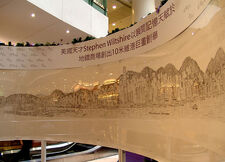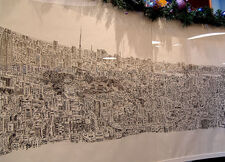(333JEK) |
Tag: sourceedit |
||
| (6 intermediate revisions by 4 users not shown) | |||
| Line 1: | Line 1: | ||
| + | {{Infobox Person |
||
| − |   |
||
| + | |name= |
||
| + | |image=Stephen wiltshire.jpg |
||
| + | |birth_date=April 21, 1974 |
||
| + | |birth_place=London, England |
||
| + | |death_date= |
||
| + | |death_place= |
||
| + | |resides= |
||
| ⚫ | |||
| ⚫ | |||
| + | == Early Life == |
||
| ⚫ | '''Stephen Wiltshire''' (born 1974) is an [[autistic savant]] who was diagnosed with [[autism]] when he was three |
||
| + | Wiltshire was born on April 21st, 1974 in London, to Colvin and Geneva Wiltshire, who are of West Indian origins. At the age of three, he was diagnosed with [[autism]]. The same year (1977) his father died in a motor cycle accident. He was [[nonverbal]] during his early childhood, beginning to speak at age five and becoming fully verbal by age nine. |
||
| − | + | At age four, he was sent to a London school named Queensmill School. He had a [[Special Interests|special interest]] in artwork from an early age, and by the time he was eight, he had started to draw seriously. His early work focused on cars, and post-earthquake cityscapes. His teachers encouraged him to draw. |
|
| + | == Artistic Talents == |
||
| − | In February, 1987, BBC aired a program about autistic |
+ | [[Image:Victoria Harbour by Stephen Wiltshire.jpg|thumb|225px|rifht|Victora Harbour]]In February, 1987, BBC aired a program about autistic savants. One section of the program covered 13-year-old Stephen Wiltshire. He drew before the camera an accurate image of St. Pancras station, which he had visited first time just few hours before. |
| − | {| border="1" cellpadding="1" cellspacing="1" style="width: 500px;" |
||
| − | ! scope="col"| |
||
| − | ! scope="col"| |
||
| − | |- |
||
| − | | |
||
| − | | |
||
| − | |- |
||
| − | | |
||
| − | | |
||
| ⚫ | |||
| − | + | The drawing was remarkable and complete with all the details as Stephen Wiltshire had seen the same exactly at 11:20. The program attracted a lot of public attention, and BBC received many telephone calls and inquiries about the talented boy. Ultimately, an entire volume of his works entitled ''Drawings'' was published in 1987 by J.M. Dent & Sons, Ltd (London). |
|
His other published works include: |
His other published works include: |
||
*''Cities'' ( J.M. Dent & Sons, London, 1989) |
*''Cities'' ( J.M. Dent & Sons, London, 1989) |
||
| − | *''Floating Cities'' (Summit Books, New York, 1991), containing drawings of Venice, Amsterdam, Leningrad and Moscow. |
+ | *''Floating Cities'' (Summit Books, New York, 1991), containing drawings of Venice, Amsterdam, Leningrad and Moscow. It was a ''Sunday Times'' number one best-seller. |
| + | *''Stephen Wiltshire's American Dream'' (Michael Joseph, London, 1993) depicts his drawings of U.S. architecture and the desert landscape of Arizona. |
||
| − | Stephen Wiltshire has always concentrated on architectural drawings |
+ | Stephen Wiltshire has always concentrated on architectural drawings and paintings: |
* At the age of ten, he created drawings which came to be known as London Alphabet, depicting places in London beginning with all the characters of the alphabet from A to Z. The drawings began with the Albert Hall and ended with the London Zoo, with many other monuments like the the House of Parliament and the Imperial War Museum in between. |
* At the age of ten, he created drawings which came to be known as London Alphabet, depicting places in London beginning with all the characters of the alphabet from A to Z. The drawings began with the Albert Hall and ended with the London Zoo, with many other monuments like the the House of Parliament and the Imperial War Museum in between. |
||
| Line 33: | Line 35: | ||
==Recognition== |
==Recognition== |
||
| + | [[Image:Tokya by Stephen Wiltshire.jpg|thumb|225px|left|Tokyo]] |
||
| ⚫ | Stephen Wiltshire's abilities have been widely recognized. Sir Hugh Casson, former president of the [[wikipedia:Royal Academy|Royal Academy]], had praised the special abilities of Stephen Wiltshire in these words: ''"Happily, every now and then, a rocket of young talent explodes and continues to shower us with its sparks. Stephen Wiltshire — who was born with severe speech difficulties — is one of those rockets ... His sense of perspective seems to be faultless… I've never seen in all my competition drawing such a talent, such a natural and extraordinary talent, that this child seems to have, is possibly the best child artist in Britain."''<ref>[http://www.wisconsinmedicalsociety.org/savant/wiltshire.cfm Islands of Genius - Stephen Wiltshire]</ref> |
||
| + | |||
| − | <ref>[http://www.stephenwiltshire.co.uk/index.aspx Stephen Wiltshire's website]</ref> |
||
| ⚫ | Stephen Wiltshire's abilities have been widely recognized. Sir Hugh Casson, former president of the [[wikipedia:Royal Academy|Royal Academy]], had praised the special abilities of Stephen Wiltshire in these words: ''"Happily, every now and then, a rocket of young talent explodes and continues to shower us with its sparks. Stephen Wiltshire — who was born with severe speech difficulties — is one of those rockets ... His sense of perspective seems to be faultless… I've never seen in all my competition drawing such a talent, such a natural and extraordinary talent, that this child seems to have, is possibly the best child artist in Britain."''<ref>[http://www.wisconsinmedicalsociety.org/savant/wiltshire.cfm Islands of Genius - Stephen Wiltshire]</ref><ref>[http://www.stephenwiltshire.co.uk/index.aspx Stephen Wiltshire's website]</ref> |
||
| + | |||
| + | Dr. Oliver Sacks speaks on Wiltshire's skill in his 1995 book ''An Anthropologist on Mars.''<blockquote><nowiki>"I thought how unlike a Xerox machine he was. His pictures in no sense resembled copies or photographs, something mechanical and impersonal - there were always additions, subtractions, revisions, and, of course, Stephen's unmistakable style ... Stephen's drawings were individual constructions, but could they be seen, in a deeper sense, as creations?''</nowiki><ref name=":0">[http://www.independent.co.uk/news/uk/this-britain/honour-for-autistic-man-who-speaks-through-art-521594.html The Independent: Honour for autistic man who speaks through art] (content warning for ableist language)</ref></blockquote>In 2006, Stephen Wiltshire was appointed MBE (Member of the British Empire) for his services to art.<ref name=":0" /> |
||
==References== |
==References== |
||
| − | <references/> |
+ | {{Small|<references/>}} |
{{wikipedia}} |
{{wikipedia}} |
||
Revision as of 12:42, 25 May 2017
Stephen Wiltshire (born 1974) is an autistic savant who was diagnosed with autism when he was three years old. Over a period of time, his autistic savant abilities developed and he became an accomplished architectural artist.
Early Life
Wiltshire was born on April 21st, 1974 in London, to Colvin and Geneva Wiltshire, who are of West Indian origins. At the age of three, he was diagnosed with autism. The same year (1977) his father died in a motor cycle accident. He was nonverbal during his early childhood, beginning to speak at age five and becoming fully verbal by age nine.
At age four, he was sent to a London school named Queensmill School. He had a special interest in artwork from an early age, and by the time he was eight, he had started to draw seriously. His early work focused on cars, and post-earthquake cityscapes. His teachers encouraged him to draw.
Artistic Talents

Victora Harbour
In February, 1987, BBC aired a program about autistic savants. One section of the program covered 13-year-old Stephen Wiltshire. He drew before the camera an accurate image of St. Pancras station, which he had visited first time just few hours before.
The drawing was remarkable and complete with all the details as Stephen Wiltshire had seen the same exactly at 11:20. The program attracted a lot of public attention, and BBC received many telephone calls and inquiries about the talented boy. Ultimately, an entire volume of his works entitled Drawings was published in 1987 by J.M. Dent & Sons, Ltd (London).
His other published works include:
- Cities ( J.M. Dent & Sons, London, 1989)
- Floating Cities (Summit Books, New York, 1991), containing drawings of Venice, Amsterdam, Leningrad and Moscow. It was a Sunday Times number one best-seller.
- Stephen Wiltshire's American Dream (Michael Joseph, London, 1993) depicts his drawings of U.S. architecture and the desert landscape of Arizona.
Stephen Wiltshire has always concentrated on architectural drawings and paintings:
- At the age of ten, he created drawings which came to be known as London Alphabet, depicting places in London beginning with all the characters of the alphabet from A to Z. The drawings began with the Albert Hall and ended with the London Zoo, with many other monuments like the the House of Parliament and the Imperial War Museum in between.
- A 2001 BBC documentary named Fragments of Genius reveals the unique drawing talent of Stephen Wiltshire. He is flown in a helicopter over London for sometime, and after landing, he drew in about three hours 12 landmarks and 200 other buildings as he has seen during his helicopter ride. The details were remarkably accurate.
He has always liked music as a listener and as an amateur singer singing to the tune of the music he was listening to. However, in 1993, it was discovered that he has also good musical abilities with perfect pitch. Oliver Sack's 1995 book An Anthropologist on Mars, describes artistic and musical abilities of Stephen Wiltshire.
Recognition

Tokyo
Stephen Wiltshire's abilities have been widely recognized. Sir Hugh Casson, former president of the Royal Academy, had praised the special abilities of Stephen Wiltshire in these words: "Happily, every now and then, a rocket of young talent explodes and continues to shower us with its sparks. Stephen Wiltshire — who was born with severe speech difficulties — is one of those rockets ... His sense of perspective seems to be faultless… I've never seen in all my competition drawing such a talent, such a natural and extraordinary talent, that this child seems to have, is possibly the best child artist in Britain."[1][2]
Dr. Oliver Sacks speaks on Wiltshire's skill in his 1995 book An Anthropologist on Mars.
"I thought how unlike a Xerox machine he was. His pictures in no sense resembled copies or photographs, something mechanical and impersonal - there were always additions, subtractions, revisions, and, of course, Stephen's unmistakable style ... Stephen's drawings were individual constructions, but could they be seen, in a deeper sense, as creations?''[3]
In 2006, Stephen Wiltshire was appointed MBE (Member of the British Empire) for his services to art.[3]
References
- ↑ Islands of Genius - Stephen Wiltshire
- ↑ Stephen Wiltshire's website
- ↑ 3.0 3.1 The Independent: Honour for autistic man who speaks through art (content warning for ableist language)
Template:Wikipedia
